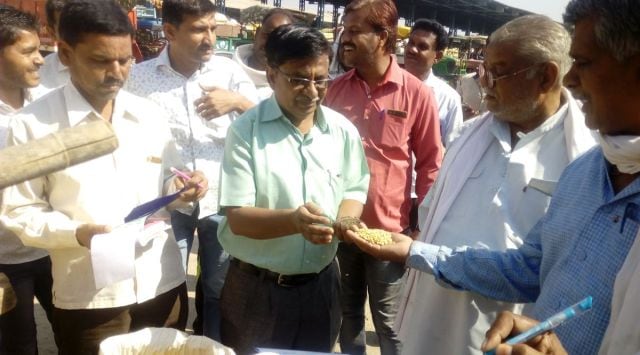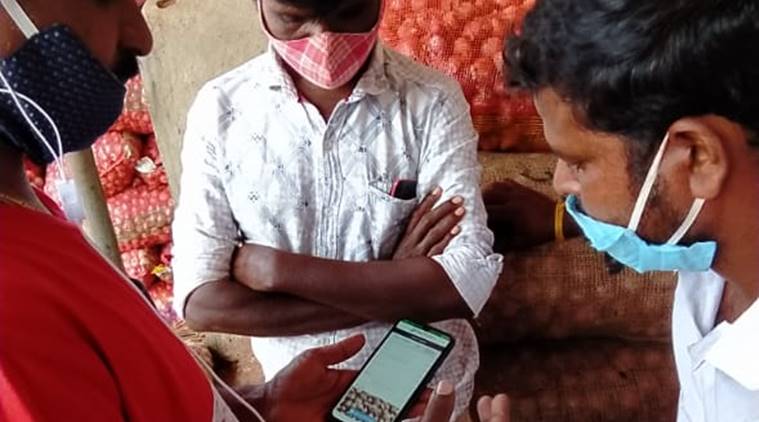- India
- International
From bites to bytes: Startups use AI for instant quality check of farm produce
How some startups are using AI for instant quality assessment of farm produce to tame pricing power of traders – in and outside APMCs
 Traders sampling a soyabean farmer's produce at Madhya Pradesh's Harda mandi. (Harish Damodaran)
Traders sampling a soyabean farmer's produce at Madhya Pradesh's Harda mandi. (Harish Damodaran)A major legacy of the ‘Amul model’ is that dairy farmers today are paid not just for the quantity, but also quality, of milk they supply. Both cooperative and private dairies fix the purchase price of milk based on its fat and solids-not-fat content. The Gerber centrifuge and lactometer that measure these enable farmers to be paid more for the same volume of milk containing higher total solids.
This benefit, of receiving a price linked to quality, isn’t available to other farmers, more so in crops that – unlike milk or sugarcane – are sold through APMC (agricultural produce market committee) mandis. Even where some quality premium is given, it is a result of subjective assessment. Soyabean traders hardly check for oil. They visually inspect grain samples drawn from a farmer’s lot to gauge size uniformity and the extent of damaged/discoloured beans or foreign matter. Moisture level is determined by simply biting the bean. The moisture is low if it cracks and high (unacceptable) if the teeth sink in. Pungency of chilli is ascertained by feeling it on the tongue and the colour by seeing the inside of the fruit.
The loser is the farmer, who cannot bargain with traders encircling his grain unloaded in the mandi auction platform. There’s no equivalent of a Gerber-lactometer reading that he can cite to demand a better price, even if his crop is above “fair average quality”. But can produce quality be assessed without depending on the eyes, nose and tongue of people? And can it be done at the mandi – that too, instantly?
Column | The men behind APMC, MSP and procurement
This is where new artificial intelligence (AI) technologies – computer vision and spectrometry – hold promise.
“AI is about seeing like a computer, but analysing like a human being. Just as the Tesla self-driving car is trained to recognise red lights and roads, and know when to stop and when to move, we can replace humans with machines to do both physical and chemical analysis of food. Such analysis would be instant, on the spot and without going to a lab,” says Taranjeet Singh Bhamra, CEO of AgNext Technologies.

His Indian Institute of Technology (IIT) Kharagpur-incubated company has developed machine-learning algorithms that can do quality assessment of various farm produce “in 30 seconds”. That includes physical analysis through computer vision. “We have a handheld device SpecX Visio that you can take to the mandi and click a picture of a sample of, say, rice. It will digitise that image and immediately tell how many of the grains are broken, shriveled, weevilled (bored by insects) or chalky (opaque),” claims Bhamra.
 A trader uses Intello Lab’s mobile app at Lasalgaon onion market in Maharashtra.
A trader uses Intello Lab’s mobile app at Lasalgaon onion market in Maharashtra.
AgNext has also come out with an AI-based solution to undertake fine leaf count in tea. “Tea that is plucked could be one bud one leaf, one bud two leaves, one bud three leaves or even banjhi (no bud). We can through image recognition – computer eye instead of human eye – accurately count as well as classify leaves, buds, banjhi and shoots in any sample,” he tells The Indian Express.
That apart, AgNext has built algorithm models based on spectrometry to analyse the chemical characteristics of food. It draws on the concept that when light is thrown at different wavelengths on an object, that object (produce) would generate a reflectance spectrum graph. Each of its molecules will, in turn, have a unique signature in that graph. The molecular signature of the chemical of interest – it could be curcumin (the key active ingredient in turmeric), capsaicin (which imparts pungency to chilli), polyphenols in tea, caffeine in coffee, nicotine and chloride in tobacco, gluten in wheat and amylose in paddy – can then be analysed and an AI model developed after scanning several samples of the produce.
“We have prepared reflectance graphs for many commodities. It is a lot of grunt work. In turmeric alone, we collected 7,000-8,000 samples, whose curcumin content varied from 2-3% in Punjab and Haryana to 3-5% in Erode (Tamil Nadu), Nizamabad (Telangana) and Sangli (Maharashtra) and 6-7% in Manipur. This was followed by their lab analysis, scanning using our device, correlating and building the whole model. For tea, we collected over half-a-million leaves to analyse and annotate each image to teach a computer to detect it,” explains Bhamra.
ExplainSpeaking | What farmers should be demanding instead of MSPs?
AgNext’s SpecX series of computer vision and spectrometry algorithms-based devices – one of them can instantly analyse even protein, lactose and the presence of adulterants such as palm oil in milk – operate on a common AI ‘Qualix’ platform. Being lightweight, they can be taken to the field, with internet connection required only to transfer data onto the platform.
The Mohali (Punjab)-based startup isn’t the only one working on eliminating subjectivity in quality analysis of agri-commodities through digitisation and AI – what Bhamra calls “converting bites to bytes”. There are others like Intello Labs and Nebulaa Innovations Private Ltd, whose founders are again from IIT Bombay and Jodhpur, respectively.
“Most mandis have no systems to objectively grade produce based on colour, size and visual defects. Quality assessment should become digital, verifiable and scalable. Once produce is automatically graded and standardised, the power of assaying will get democratised and taken away from traders,” points out Milan Sharma, CEO of Intello Labs.
 AgNext Technologies’ Taranjeet Singh Bhamra.
AgNext Technologies’ Taranjeet Singh Bhamra.
The Gurugram-headquartered company’s mobile app Intello Track uses neural network machine learning algorithms to analyse physical quality of fruits & vegetables. The app captures images of a representative sample of the produce that is brought and categorises it as grade A, B or C. Thus, grade A onions are defect-free and of 40-55 mm diameter, while grade B will have no skin with below 40 mm or above 55 mm size. In Grade C onions, there would be cuts or cracks with double patti (skin), sprouting and smut infection.
“We also have a handheld NIR (near infrared spectroscopy) scanner that measures Brix/total soluble solids for sweetness, pH, dry matter, moisture and pesticide residues in apples, mango, papaya and sapota. In all, we have algorithms for 55 horticultural produce” adds Sharma.
Nebulaa’s MATT Grain Analyser can, likewise, give a full morphological analysis of cereals, pulses, mustard, soyabean and cumin – from their broken and admixtures content to length/breadth ratio and thousand count weight – “within 1 minute”, states the company’s website.
Explained | Can Punjab declare entire state ‘Principal Market Yard’? What are the implications?
The question is: How much can all this so-called Deep Tech get deployed on the ground? Will they get a fillip, thanks to the recent reforms that open up produce trading outside APMCs?
Shekhar Pallela, a commission agent at India’s largest chilli mandi in Guntur (Andhra Pradesh), feels they would be used only by companies that buy directly from farmers. An ITC, AVT or Synthite Industries may procure chilli in some areas from growers who practice integrated pest management, “but in our market yard, farmers sell through us and the existing system (of subjective quality assessment) will continue”.
According to Unupom Kausik, president of the commodity warehousing firm National Collateral Management Services Ltd, the success of AI-based quality assessment depends on the creation of an “exhaustive library” of images from millions of crop samples. “Whatever images the handheld devices capture have to be compared and correlated with this library. You are eventually competing with 35-40 pairs of eyes with 25 years experience looking at the same grain heap,” he notes.
AgNext’s Bhamra expects the demand for Deep Tech to come mainly from processors. He cites a major ghee maker, which wants to ensure its milk suppliers aren’t skimming off butter fat and replacing it with cheaper palm oil. Another example is a starch extractor company that receives around 100 trucks of broken rice and wheat daily. For each truck, physical analysis of the grain and starch content determination at the factory’s laboratory translates into long lines and waiting time.
“If this analysis can be pushed to the primary procurement point, the truck can be approved even before it starts. Breweries and animal feed makers can similarly gain from instant quality estimation of barley or maize at the mandi itself, instead of the plant,” he sums up.
Apr 18: Latest News
- 01
- 02
- 03
- 04
- 05






































